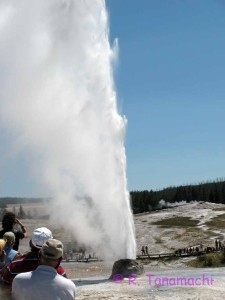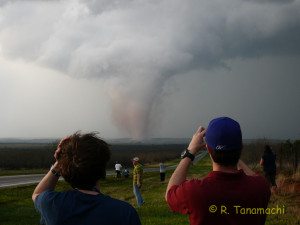Very early this morning, I was jarred awake by a rumor that Tim Samaras, his son Paul, and fellow storm chaser Carl Young passed away in the El Reno, OK tornado on Friday. I was unable to independently confirm the rumor, but it originated from a reliable source. The more I thought about it, the more the puzzle pieces fit together: Seven in-vehicle fatalities were confirmed in Friday’s El Reno tornado (which my husband and I witnessed from the vicinity of Union City, OK), of which four had been either publicly identified or described, leaving three people undescribed and unidentified. Tim Samaras’ Facebook and Twitter feeds had both been ominously silent since mid-Friday afternoon. This morning, our worst fears were confirmed by Tim’s brother Jim.
I will admit that I did not know Paul Samaras and Carl Young very well, but likely rubbed elbows with them at chaser conventions, picnics, and meetings. Tim Samaras can introduce himself to you in this “About Me” video on his web site.
I first met Tim in the field in 2004, on a storm chase near the Kansas-Nebraska border. I don’t recall the exact date, but it was one of the first times I had gone chasing in the UMass W-band radar as its primary operator. We found Tim and his TWISTEX crew waiting for CI just north of (I think) Beloit, Kansas. Howie Bluestein (my graduate adviser) introduced me to Tim, and Tim asked if I would be willing to collect W-band radar data over his probes if he had a successful deployment that day. He talked directly to me, not to Howie. Here I was, still relatively new in the field and wet behind the ears, and Tim was inviting me to collaborate! If memory serves, that day was a bust – the cumuli bubbled, but tornadic storms were not to be had.
Tim’s primary instruments in the early 2000s were a set of probes called Hardened In Situ Temperature and Pressure Recorders (HITPRs). A HITPR was about the same size and shape as an Asian conical straw hat, and painted bright orange to make it easy to find if it was moved or covered in debris. The HITPR was basically a miniaturized version of the TOTO probe that was used in early 1980s tornado intercepts, with the distinct advantage of having multiple copies. This 4-minute video from National Geographic shows how Tim used the HITPRs to collect measurements in the 2003 Manchester, South Dakota tornado. These and other measurements confirmed some of our conceptual models about pressure fields in tornadoes.
Tim also built a larger probe, containing seven video cameras, to record a tornado’s passage at close range for photogrammetric analysis. All seven cameras had to begin recording with the flip of a single switch – no easy engineering feat. His probe designs were frequently imitated, but never replicated. The video he took in the 2004 Storm Lake, Iowa tornado is on his jaw-dropping Driven by Passion DVD, which occupies a high spot on my chase DVD shelf and which I still use instructionally to demonstrate the perils associated with flying debris. (A sample can be seen at about 2:40, here.)
Tim’s deployment strategy involved getting very close to tornadoes, but he was NOT one of the debris-kissing yahoos. He had genuine intellectual curiosity and the skills to build instruments needed to address crucial scientific questions. He presented his results eloquently at scientific conferences and submitted them for peer-reviewed publication. He was also a multimedia wizard, perfectly synchronizing side-by-side video and measurement traces. And finally, he was a solid media personality, appearing for several years in National Geographic specials and a season or two on the Discovery Channel’s Storm Chasers with his TWISTEX program. Whenever Tim was on the screen, you knew there would be minimum drama and maximum science.
Tim Samaras’ loss leaves a raw and painful void in tornado research. There is literally no one else in my field who possesses the multifaceted portfolio of expertise in engineering, science, writing, videography, and entertainment that he did. I am still gobsmacked at the news of his passing, and stunned to hear that it occurred so close to us. But the grief of the severe weather research and storm chaser communities can only pale in comparison to the grief endured by their families and friends. My deepest sympathies go out to the Samaras and Young families. They can take comfort in knowing that Tim Samaras and his crew were a class act, universally well-respected, and represented the best of our community.
Update, 7:51 p.m. CDT: My former graduate adviser Howie Bluestein (whom I mentioned above) gave me permission to re-post his tribute to Tim, which was sent out in his daily status message to his colleagues:
Hi all: I am sad and shocked to tell those of you who have not already heard that Tim Samaras, his son Paul, and Carl Young died while chasing the El Reno tornado on Friday. While I have been receiving unconfirmed reports of this since early this morning, the most recent, from Channel 7 in Denver (via Lou Wicker), seems to confirm this tragic news. I have known Tim for many years as someone who shared our enthusiasm for severe weather. He designed some of the early miniature instruments deployed in the paths of tornadoes, particularly those with video cameras and temperature and pressure sensors. His work has been showcased and supported in part by the National Geographic Society, and displayed at the Denver Science Museum. More recently he has been working with high-speed lightning cameras. We have in the past, for a number of years, shared our groups’ status-update messages. He and Roger Hill ran the very successful National Tornado Chasers’ Convention in Denver each February. He was always a gentleman and shared his enthusiasm with the community. While not an academic or a member of a meteorological research laboratory, he has had a profound influence on all of us, and in particular through publications of the analyses of his data from TWISTEX.

